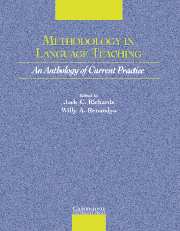Book contents
- Frontmatter
- Contents
- Acknowledgments
- Introduction
- Section I Approaches to Teaching
- Section 2 Lesson Planning and Classroom Management
- Section 3 Classroom Dynamics
- Section 4 Syllabus Design and Instructional Materials
- Section 5 Task and Project Work
- Section 6 Learning Strategies
- Section 7 Teaching Grammar
- Section 8 Teaching Pronunciation
- Section 9 Teaching Speaking
- Section 10 Teaching Listening
- Section 11 Teaching Vocabulary
- Section 12 Teaching Reading
- Section 13 Teaching Writing
- Section 14 Assessment
- Section 15 Technologies in the Classroom
- Chapter 36 Video in the ELT Classroom: The Role of the Teacher
- Chapter 37 The Internet for English Teaching: Guidelines for Teachers
- Chapter 38 What Can the World Wide Web Offer ESL Teachers?
- Section 16 Professional Development
- Credits
- Author Index
- Subject Index
- References
Chapter 38 - What Can the World Wide Web Offer ESL Teachers?
Published online by Cambridge University Press: 10 November 2010
- Frontmatter
- Contents
- Acknowledgments
- Introduction
- Section I Approaches to Teaching
- Section 2 Lesson Planning and Classroom Management
- Section 3 Classroom Dynamics
- Section 4 Syllabus Design and Instructional Materials
- Section 5 Task and Project Work
- Section 6 Learning Strategies
- Section 7 Teaching Grammar
- Section 8 Teaching Pronunciation
- Section 9 Teaching Speaking
- Section 10 Teaching Listening
- Section 11 Teaching Vocabulary
- Section 12 Teaching Reading
- Section 13 Teaching Writing
- Section 14 Assessment
- Section 15 Technologies in the Classroom
- Chapter 36 Video in the ELT Classroom: The Role of the Teacher
- Chapter 37 The Internet for English Teaching: Guidelines for Teachers
- Chapter 38 What Can the World Wide Web Offer ESL Teachers?
- Section 16 Professional Development
- Credits
- Author Index
- Subject Index
- References
Summary
INTRODUCTION
The rapid growth of the Internet, which links computers all over the world into a single electronic communications network, is in the process of making widespread computer-based instruction a reality. This is owing largely to the advent of the World Wide Web, a system for accessing and viewing information on the Internet. Web browser software such as Mosaic or Netscape permits easy viewing of texts stored on machines all over the Internet and they can display graphics, transmit sounds, and even play movies in the form of digitized video.
The ease with which Web documents can be created, as well as their worldwide accessibility, multimedia capabilities, and interactive functions, make the Web an attractive environment for carrying on computer-based instruction. From the viewpoint of English language instruction, an added advantage is the fact that at present, Web documents, which cover a huge set of subject matters, are mostly written in English, with new documents continually appearing. The Web thus offers a rich database of authentic material.
We have been examining how this new medium can be utilized for ESL instruction. We have learned that the Web is not only a tremendously effective means for disseminating instructional materials, but that it can also provide a context for efficient collaborative materials development.
- Type
- Chapter
- Information
- Methodology in Language TeachingAn Anthology of Current Practice, pp. 374 - 384Publisher: Cambridge University PressPrint publication year: 2002
References
- 3
- Cited by



